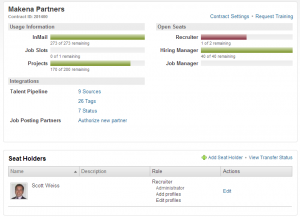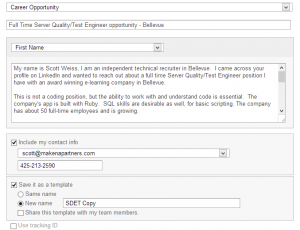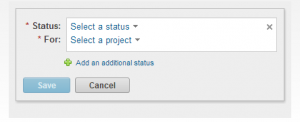I have been an avid LinkedIn user since 2005, using the system as a means to drive both the recruiting and business development aspects of my business. A few years back I upgraded to a Premium account at $99/month which gave me a couple of core features: InMails, and Profile Organizer. I felt pretty confident I had all I needed on a budget I could live with, but then I heard about LinkedIn Recruiter Corporate Edition, and felt compelled to take a look.
When I filled out the “request a demo” form on the Recruiter landing page, my intention was to conduct a comparison analysis to see if Recruiter had more to offer then my Premium account, at the time called “Talent Finder”. One of the things I really liked about Talent Finder was the self-service approach to upgrading – I could upgrade or downgrade at anytime, with the push of a button, and with no human interaction (i.e. no talking with a sales rep), plus I never had to sign any kind of contract (always month to month).
One of the first things I learned about Recruiter was that a subscription required an annual contract — a scary proposition for a small business owner with an untested service. I had multiple demos of the software and an aggressive (but knowledgeable sales rep who walked me through all of Recruiter’s features, and why they were better then Talent Finder’s. At times, it felt like LinkedIn was competing with itself — on one hand, the marketing/product team invests heavily in self-service upgrades through the site, and here I have a commissioned sales representative selling me on her offering vs. the self-service one — a classic example of internal channel conflict. It made sense to me though, and is a great case-study of a classic problem with web-based offerings — self-service vs. direct sales, or Product/Marketing vs. Sales/Marketing. In a perfect world, the product would do the selling itself but we all know that buyers tend to be gun-shy and sometimes it takes an aggressive sales person (not machine) to make that emotional appeal to get the buyer over the edge. In the case of Recruiter, it worked – I finally broke down and signed my year contract, still somewhat unconvinced I was getting anything better then what I already had at $99/month (now I’d be spending $450/month on a 1-year contract).
Here were the features Recruiter could offer me that a personal Premium account could not:
1. Seats
Recruiter sells its service with “seats” similar to Salesforce.com. An account administrator controls who those seats are assigned to, and can change them at any time. When I signed up for Recruiter, I had a full-time employee working for me as a talent sourcer. She had upgraded her LinkedIn account to Premium and I was reimbursing her the $99/month she spent with her own credit card (I didn’t want her account tied to mine). Beyond the issue of asking your employee to pre-purchase a business tool he/she will be using in their role at your company, I had no access to any of the data she complied (messages, profiles, etc.) while on the job. Recruiter fixed that be giving me access to anything she did, and the trail left behind when and if she moved on to a new company.
With seats, you can also pool your in-mails. Recruiter gives each seat 50 new in-mail credits per month, and these roll over if unused. So right out of the gate, between my employee and I we had 100 in-mail credits that she could use all on her own if I had no sourcing I planned to do on my own.
On top of that, at any time I could re-assign her seat to another email address/user, or leave it un-assigned and take the in-mail credit pool for myself.
2. Candidate Database
With a Premium Account on LinkedIn, you can search the profile database and return results of users you are 1st and 2nd degree connected to, share a group with, and that’s about it. You might get some info about a 3rd party connection but very little, certainly not enough to determine if that profile is worth using an in-mail credit on.
With Recruiter, the entire LinkedIn profile database is exposed, regardless of your connection to that user. Its everything we’ve always wanted Monster and CareerBuilder to be — a highly filterable search mechanism on top of essentially the entire workforce in your specific area of recruiting focus. For sales and recruiting professionals, it’s heaven-sent.
3. Bulk In-Mails
One of the things that frustrated me the most about my Premium account was having to cut and paste my in-mail messages when I wanted to send the same message to multiple people. Recruiter allows you to add profiles to a “clipboard” as you search, then select all of the profiles you want to send one specific message to. They have a robust email template feature which lets you save email messages and re-use them in the future, and also customize fields so that the name of each specific profile is added to your message when you send it in bulk. Now, what might have taken me 30 minutes takes 5 because I can “blast” my message to a large number of people at one time.
4. Projects
The Projects feature of Recruiter allows you to build/manage robust folders with information about profiles associated to that specific project. This is where Recruiter behaves like a CRM, and works great for recruiters that often work on similar positions – the work you did on the Java Web Application developer role 3 months ago becomes relevant and useful when you have a similar role and need to quickly identify candidates for it.
5. Profile Notes/Status
Diving into a specific candidate profile, I can do any number of things to keep track of my activity associated to that person. The most useful features are Statuses (i.e. Applied, Contacted, Do Not Contact), Notes, and Tasks.
5. Job Slots
Most contracts for a LinkedIn Recruiter license come bundled with a “Job Slot”, or a permanent job listing in the LinkedIn Jobs network. It never hurts to create more in-bound candidate applications, so this to me was icing on the cake. You can change the job you have posted at anytime, and always have at least 1 (or however many job slots you purchase) job advertising running through the site. I’ve been surprised at the number of applications I’ve received from non-US candidates, but I still find it valuable to have my jobs being promoted through LinkedIn, even just for branding of my company.
WHAT’S MISSING:
No software product review would be complete without a “wishlist” of features – every user has them. In the case of Recruiter, I only have one.
LinkedIn has built a reputation as a business/career networking service for “passive” job seekers – that is, candidates who are not actively looking for jobs, but maintain a professional profile just in case an amazing opportunity shows up at their door. However, a good percentage of the 500 Million+ users of the site are ACTIVELY looking for work – I know this because I’ve used resume database services like Dice and Monster and just about every resume I see has a corresponding profile on LinkedIn.
These active job seekers are resolved to sprinkling keywords like “seeking”, “available” and “looking” into their LinkedIn profile summary, in the hopes that a recruiter stumbles across them using these search terms. As both a direct hire and contract/contract-to-hire recruiter, I’m often times looking for candidates who may be out of work and available to start a position immediately. LinkedIn does not make this easy for me, and I’m spending the money I could otherwise be giving them on services like Indeed Resume Search, Dice and others.
So, my pitch to LinkedIn is this: let “active” job seekers opt their profiles into a sub-set of your database, accessible only by customers who subscribe to this “sub” database. There, I can search only “active” candidates and contact them directly, vs. trying to determine which profiles in my searches are candidates who are in fact looking for work. I’d gladly pay for this additional feature, and I’m sure many other Recruiter customers would as well (especially staffing agencies).
In summary: I’m now 4 months into my Recruiter contract and feel very good about the decision I made to upgrade. I can trace at least 2 placements back to candidates I discovered through the platform and dozens of new business relationships.
Feel free to reach out to me if you have any specific questions about the solution – I had trouble finding testimonials when I was going through my buying cycle, so hopefully this post will help you decide whether or not LinkedIn Recruiter is right for you.


